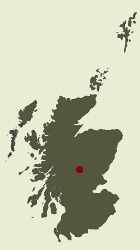 The Fortingall Yew
The Fortingall Yew
All over this website, most of the "old" stuff is manmade: Calanais, the Brochs, Iona, Kilmartin, etc... Structures that now breathe in harmony with the environment they inhabit.
But Scotland also harbours a living organism that is thousands of years old. Estimates vary between 2,000 (making it the oldest living thing in Britain) up to some 5,000 years old. Now it won't beat Old Tjikko, a spruce in Sweden - reputedly 9,550 years old - but it is a very respectable age most trees won't reach.
So here it is: 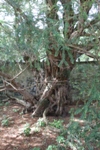 the Fortingall Yew, a European yew or in fancy Latin - Taxus baccata.
the Fortingall Yew, a European yew or in fancy Latin - Taxus baccata.
Residing in the middle - well, roughly the middle - of Scotland, legend has it that Pontius Pilate was born in its shade and played there as a child. I leave you to be the judge of this myth.
There are some facts, however, that can be better substantiated.
According to records of 1769 the tree once had a girth of some 17 metres. It is considerably smaller today and it was not just age that reduced its size.
Unfortunately, fame started to draw treasure hunters who not only gazed at it, but thought the proper thing to do next was simply cut off parts of a thousands-years-old tree. Children lit fires in the heart of the tree. Lastly, entire funeral processions passed through its midst - it is situated right next to a wee church.
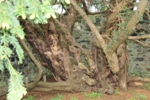 A few centuries later, history enthusiasts, underage arsonists and village... people caused the gigantic yew to split into several stems, as if it is different trees. Obviously, as the heartwood rings are gone, it is now impossible to date. So optimists give it a life-span of 5,000 years, whereas the careful analyst will take the lowest figure. Maybe we should take an average.
A few centuries later, history enthusiasts, underage arsonists and village... people caused the gigantic yew to split into several stems, as if it is different trees. Obviously, as the heartwood rings are gone, it is now impossible to date. So optimists give it a life-span of 5,000 years, whereas the careful analyst will take the lowest figure. Maybe we should take an average.
All this said, the tree's precarious condition required safety measures, so today's visitors can only view the yew behind a wall and a gate. As I took these pictures, it's quite clear you can still admire the tree, but it is a pity all the same. Such a "big" part of history surely deserves a better view than the dark corner it has today.
If the tree itself is not "mythical" enough, something magical happened in 2015.
Up till 2014, the Fortingall Yew was an old man. Like all yews, it is quite easy to sex the trees in autumn. Male trees then have small spherical structures
which release clouds of pollen when they mature. 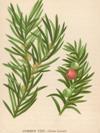 Female yews, on the other hand, produce bright red berries that one can detect from autumn until winter.
Female yews, on the other hand, produce bright red berries that one can detect from autumn until winter.
The Fortingall Yew, as of 2015, is a transgender. Its passport should have an X, neither male nor female. Aye, indeedie, this impressive bit of historic vegetation officially started changing sex. One of its upper branches suddenly sported red berries ... which biology enthusiasts cut off for further investigation.
So much for freedom of expression.
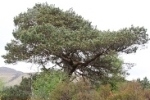 Home
Home

